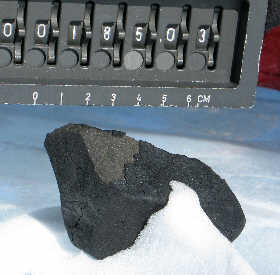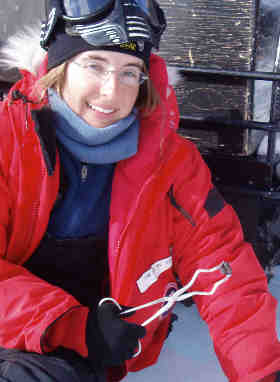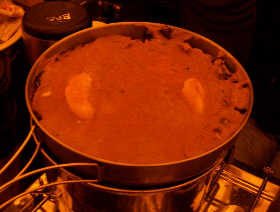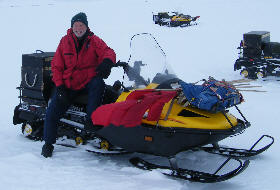ANSMET team • Jan 09, 2009
The Antarctic search for meteorites: 237 meteorites await the long drive to Houston
January 5-8, 2009

Space vagabond
ANSMET
Amy collects a treasure
ANSMETTraveler
January 5, 2009
Near the end of the day that we obtained our massive haul of 55 meteorites, a softball-sized mass beckoned us from the edge of the moraine. All of us recognized this rock was unique - it has a thin, very black fusion crust with a bit more shine than usual, and with small, hexagonal cracks on its surface. Beneath this layer is a nearly uniform, steel-grey interior with a few tiny crystals that gleamed in the sunlight. Those more experienced meteorite hunters claimed immediately it was an achondrite, a kind of meteorite formed by melting the rock completely sometime during its formation, separating out certain elements and minerals. This is a complicated process that occurs on large bodies, like Earth, the Moon, other planets, and some large asteroids. Most meteorites (over 95%) we find out here were formed almost at the beginning of the solar system, out of bits of rock and dust that were never organized into planets, and are called ordinary chondrites. Although there is no way for us to be sure, until we get it home to the lab at Johnson Space Center, that this rock isn't an ordinary chondrite that has undergone processes that have altered it since it formed, it is still fun to puzzle over its origin.
One word uttered by Duck, ultramafic, immediately triggered in me thoughts of Jupiter's moon Io. Ultramafic rocks have a high amount of iron and magnesium, and on Earth are typically found beneath the Earth's surface, in the mantle, or in deposits that signified a time when large amounts of lava poured out of the Earth due to lots of internal heat. Io is a satellite that experiences internal heating due to its proximity to and orbit around Jupiter, called tidal heating. This heat results in hundreds of active volcanoes on its surface, many of which are very hot, at least hot enough to make basalt, like you'd find on Kilauea volcano in Hawaii. As Io researchers, we have considered the possibility that some of the lava flows on Io are ultramafic, because of the large amounts of heat inside Io.
Suddenly, I was looking at this little rock with a whole new vision. The odds of getting a rock to Earth from Io are extremely slim, because Jupiter is so massive that stray objects nearby are either drawn into its orbit or are ejected from the solar system, unless some complicated solar system dynamics occur. Still, the analogy helped link my mind to this rock's history. At first, rock inside a planetary body (wherever this body was - most likely in the asteroid belt) was heated to magma, whereon it migrated to the surface and erupted as a lava flow, glowing in the vacuum of space. After this cooled, an object came screaming toward this body and smashed into the surface, launching materials into outer space. After interactions with other planets and asteroids, some of this material found itself on a path toward Earth. It hurtled its way through the atmosphere, losing lots of mass and probably breaking up as it descended, and forming a melt crust on its surface, finally impacting the giant Antarctic ice sheet. It then was covered by snowfall, where it was buried in dense ice, and was carried for perhaps tens to hundreds of thousands of years by this ice to emerge, through wind ablation or erosion of the ice, at the foot of Mount Ward.
And how lucky we were to hover over this little traveler, to look at it closely (trying not to snot on it of course), to carefully collect it, and to bring it home.
100 years ago this date: Shackleton's crew faced bitter cold, -18 F, and strong winds. Recognizing that hunger was impeding their progress, they increased their rations. They still suffer from severe headaches. Man-hauling through soft snow, they made over 15 miles toward their goal.
- Jani

Mmmmm...
ANSMET Amy enjoys a salmon, tater tot, and green bean meal, all fried in copious amounts of butter.
Meteorite meringue
ANSMET The wonderfully appropriate "meteorite meringue" dessert made by Deon and Joe for Christmas dinner, complete with pear slices representing Mt. Ward and Davis Nunataks.And how's the food?
January 6, 2009
Although we actually need more food when we are out hunting for meteorites, we often eat more as we graze on nearby chocolate, cheese, and other assorted goodies on days when we are confined to our tents by bad weather. So, after prolific snacking during a tent day today, I thought it might be appropriate to talk a bit about our dietary habits.
Working outside in Antarctica necessitates eating a lot more calories than you might eat at home. Many of those calories are needed simply for fuel to keep yourself warm. How many extra calories you need depends on your outside activities. On good weather days, we hunt for meteorites on snowmobile and on foot, along with doing some chores around camp. We probably eat around 2,500 to 3,000 calories a day, and if we eat less we will quickly notice that we are low on energy. I've found that a chocolate bar or meat stick can readily bring my energy level back up. It is interesting and sobering to compare this to the calorie intake of members of the Shackleton and Scott expeditions we have been reading about. Those parties dealt with the cold too, but without the modern cold weather gear we have to keep them warm and, most importantly, pulling several hundred pound sleds containing all their food, tents and other supplies. These men probably should have been eating 6000-8000 calories a day, but instead were often limited to less than we eat daily.
The members of ANSMET also eat very well, and in good company. Everyday meals are cooked and eaten together with your tentmate, but we often gather in groups of 4 or 6 for small Antarctic dinner parties. Dinners on Christmas and New Years were especially festive, and took place in Jani and Amy's tent, which we have self-designated the group party tent. The food we had to choose from in McMurdo to bring out to the field for our meals was pretty posh. This is because it costs so much to ship food to Antarctica, you might as well have the good stuff. Where the intrepid souls in Shackleton's and Scott's groups were limited to items like biscuits, pemmican and pony meal (stews made with meat from their former pony companions), we get to eat steaks, scallops, salmon, shrimp, a daily chocolate bar or two, and most meals include or are fried in a significant serving of butter. We were even able to order foodstuffs to be delivered on a resupply flight that came in a few days ago. I found it very ironic that while 100 years ago, not too far from where we are camped, Shackleton's and Scott's men were confined to very short rations, we were able to order curry paste for delivery to us in the field during resupply! But, I'm certainly not complaining!
100 years ago this date: Shackleton and his team continue to slog southward, facing winds and bitter cold, -22 F. They increased their rations, but not to full rations, and make 15 and a quarter miles through soft snow. They have decided that on the next day they will leave equipment behind and make a dash with the bare minimum necessities to get as far south as possible and plant the Queen's flag.
-Amy

Joe and his snowmobile
Joe is the one in the red parka.ANSMET
Snowmobiles: Not As Cuddly As the Old Dog Teams, but We Love Them
January 7, 2009
ANSMET would not be the success it has been without the ability to search vast areas of ice in relatively short periods of time. Our trusty snowmobiles have given us this ability. They provide a means of rapidly carrying us to search sites that may be some distance from camp, and do the footwork needed for systematic and reconnaissance searching. Furthermore snowmobiles are also tireless, where we aren't, nor was the other option of the distant past: dogs. While dogs might be more fun and interesting to work with (and in extremely cold weather there is nothing like a three dog night) snowmobiles are clearly the champs when it come to getting around in this environment.
We are using relatively new Scandex snowmobiles built by Bombardier. They are dependable, easy-to-use machines with 2-cylinder engines that have the performance of a “hot rod.” These are not your fathers' snowmobiles and are a great improvement over those used 5-6 years ago (Alpine I, also by Bombardier). Unfortunately, most of this high-speed performance is wasted on ANSMET. Searching for meteorites is generally a slow business!
Frequently these little machines have a name proudly inscribed on them in magic marker, similar to the way military pilots have done on their aircraft. Obviously you can become attached to your machine and realize how much you depend on it.
Snowmobiles play heavily in the start of each day. Our daily search preparation ritual starts by popping from our tents and addressing our snowmobiles (I usually say “Hi, snowmobile! Ready for a big day of searching?”). Then you go through the next ritual - the start up ritual (which in my case starts with a prayer that the thing will start). First 2-3 pumps of the primer, flip down the choke switch, put in neutral, grab the pull start cord and give 2-3 pulls, then hit the starter key. Most of the time they respond, but if not do it again.
Then comes the careful warm up, and that is a must (a cold and improperly warmed up snowmobile is a grumpy snowmobile). As the snowmobiles are idling and getting warm we all meet around John for an outline of the day’s search plan and for a group hug lead by John (well, maybe the hug is an exaggeration). Then we grab a few location flags, stowing them on the front of our “cool rides” and start off to search for meteorites as these little machines carry us tirelessly wherever we ask.
The end of the day ritual has us at the gas pump, hand cranking the pump to fill the machines for one another in preparation for the next search day. Then it is bed time for the snowmobile, face into the wind, and with the cover on if impending blowing snow is imminent.
For those past ANSMET people (and any National Science Foundation Officials reading this), before we mount our beloved machines in the morning we don our new helmets mandated by the National Science Foundation this year for all snowmobilers, no matter how slow they must drive. You will be impressed that we have all been able to effectively hide our helmets under our hoods in each search picture.
100 years ago this date: Shackleton and his men were tent-bound due to a blizzard with temperatures of -28 to -38 F with hurricane-force winds. They hope to make their dash to the south the following day, if the weather abates.
--Joe

The meteorite zone
ANSMET Each flag marks the location of a free-range meteorite. The black specks on the ice are Earth rocks.Catching-up them free-range meteorites
January 8, 2009
I could not believe my eyes or ears when I got up this morning. The tent was bright! Could it be the sun was shinning? I did not hear a mournful wail! Could it be the winds had abated? And it was warm, too. John soon confirmed my fondest hopes. "I sure hope I remember how to recognize a meteorite." he said. It's true, it's true. We are going to get out of the tents today!
We started at the normal time, 09:00, with the morning gathering. John laid out the plan of work. We were going back to The Zone, The Meteorite Zone, where herds of free-range meteorites live. The goal was to corral as many as we could so that we could herd them off to Houston at the end of the season. After Joe's post of yesterday, we even had a group hug, although I hope we never do THAT again! I mean, it's been two to four weeks since anyone last had a shower. Even a heavy parka and wind pants cannot hide that fact.
We went back to the ice at the base of Mount Ward southeast of camp. There, just downwind of a moraine but upwind of a large swell in the ice is a narrow band of ice covered with Earth rocks. Hidden among the Earth rocks is a surprising number of free-range meteorites, all of them using the Earth rocks as camouflage. We started by foot-searching parallel to the moraine. Almost immediately meteorites began to be spotted. They tried to stampede, but we rounded them up. Our first pass netted over twenty. So did our second pass. We cut the meteorites from the Earth rock herd and got them into our corral. Quite a successful round-up.
After the second foot-search round-up, we did one short sweep on ski-doos on the nearby ice and rounded up a few strays. Our catch for the day: 55 new meteorites. That makes 237 total now awaiting the long trail drive to Houston.
There is still a long, long stretch of The Meteorite Zone waiting to be searched. With good weather, who knows how many free-range meteorites we might catch-up? Yippie-kai-yay!
100 years ago this date: Shackleton and his team were still tent-bound due to a blizzard with a temperature of -40 F and hurricane-force winds. They stay in their sleeping bags, cold and hungry. They continue to hope that the bad weather will abate and that they will be able to make a dash to the south the following day.
Cheers,
LYAN
duck
Support our core enterprises
Your support powers our mission to explore worlds, find life, and defend Earth. You make all the difference when you make a gift. Give today!
Donate

 Explore Worlds
Explore Worlds Find Life
Find Life Defend Earth
Defend Earth

